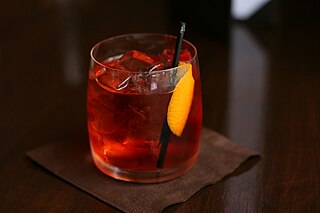
A Manhattan is a cocktail made with whiskey, sweet vermouth, and bitters. While rye is the traditional whiskey of choice, other commonly used whiskies include Canadian whisky, bourbon, blended whiskey, and Tennessee whiskey. The cocktail is usually stirred then strained into a cocktail glass and garnished traditionally with a maraschino cherry. A Manhattan may also be served on the rocks in a lowball glass.

Vermouth is an aromatized fortified wine, flavoured with various botanicals and sometimes colored. The modern versions of the beverage were first produced in the mid- to late 18th century in Turin, Italy. While vermouth was traditionally used for medicinal purposes, it was later served as an apéritif, with fashionable cafés in Turin serving it to guests around the clock. In the late 19th century, it became popular with bartenders as a key ingredient for cocktails, such as the martini, the Manhattan, the Rob Roy, and the Negroni. In addition to being consumed as an apéritif or cocktail ingredient, vermouth is sometimes used as an alternative to white wine in cooking.

The martini is a cocktail made with gin and vermouth, and garnished with an olive or a lemon twist. Over the years, the martini has become one of the best-known mixed alcoholic beverages. A popular variation, the vodka martini, uses vodka instead of gin for the cocktail's base spirit.

A Negroni is an Italian cocktail, made of one part gin, one part vermouth rosso and one part Campari, garnished with orange peel. It is considered an aperitivo.

An apple martini is a cocktail containing vodka and one or more of apple juice, apple cider, apple liqueur, or apple brandy.

Frank Thomas Moorhouse was an Australian writer. He won major Australian national prizes for the short story, the novel, the essay, and for script writing. His work has been published in the United Kingdom, France, and the United States and also translated into German, Spanish, Chinese, Japanese, Serbian, and Swedish.

The gimlet is a cocktail made of gin and lime cordial. A 1928 description of the drink was: gin, and a spot of lime. A description in the 1953 Raymond Chandler novel The Long Goodbye stated that "a real gimlet is half gin and half Rose's lime juice and nothing else." This is in line with the proportions suggested by The Savoy Cocktail Book (1930), which specifies one half gin and one half lime juice. However, modern tastes are less sweet, and generally provide for at least two parts gin to one part of the lime and other non-alcoholic elements.

"Shaken, not stirred" is how Ian Fleming's fictional British Secret Service agent James Bond prefers his martini cocktail.

The Bronx is a cocktail. It is essentially a Perfect Martini with orange juice added. It was ranked number three in "The World's 10 Most Famous Cocktails in 1934" behind the Martini (#1) and the Manhattan (#2). In the movie "The Thin Man" 1934, the lead actor compared the methods for shaking the Manhattan, the Bronx and the Martini.
The Vesper or Vesper Martini is a cocktail that was originally made of gin, vodka, and Kina Lillet. The formulations of its ingredients have changed since its original publication in print, and so some modern bartenders have created new versions which attempt to more closely mimic the original taste.

The Fine Art of Mixing Drinks is a book about cocktails by David A. Embury, first published in 1948. The book is noteworthy for its witty, highly opinionated and conversational tone, as well as its categorization of cocktails into two main types: aromatic and sour; its categorization of ingredients into three categories: the base, modifying agents, and special flavorings and coloring agents; and its 1:2:8 ratio for sour type cocktails.

The Gibson is a mixed drink made with gin and dry vermouth, and often garnished with a pickled onion. In its modern incarnation, it is considered a cousin of the ubiquitous martini, distinguished mostly by garnishing with an onion instead of an olive. But the earliest recipes for a Gibson – including the first known recipe published in 1908 – are differentiated more by how they treat the addition of bitters.

A bijou is a mixed alcoholic drink composed of gin, vermouth, and chartreuse. This cocktail was invented by Harry Johnson, "the father of professional bartending", who called it bijou because it combined the colors of three jewels: gin for diamond, vermouth for ruby, and chartreuse for emerald. An original-style bijou is made stirred with ice as Johnson's 1900 New and Improved Bartender Manual states "mix well with a spoon and serve." This recipe is also one of the oldest in the manual, dating back to the 1890s.

Lucien Alphonse Paul Gaudin was a French fencer. He competed in foil and in épée events at the 1920, 1924 and 1928 Olympics and won a gold or silver medal in every event he entered, accumulating four gold and two silver medals total. This record is tied for the best French Olympics performance, matching fencers Christian d'Oriola then followed by both Philippe Cattiau and Roger Ducret.

The Clover Club Cocktail is a cocktail consisting of gin, lemon juice, raspberry syrup, and an egg white. The egg white is not added for the purpose of giving the drink flavor, but rather acts as an emulsifier. Thus when the drink is shaken a characteristic foamy head is formed.

The boulevardier cocktail is an alcoholic drink composed of whiskey, sweet vermouth, and Campari. Its creation is ascribed to Erskine Gwynne, an American-born writer who founded a monthly magazine in Paris called Boulevardier, which appeared from 1927 to 1932.

The espresso martini is a cold caffeinated alcoholic drink made with espresso, coffee liqueur, and vodka. It is not a true martini as it contains neither gin nor vermouth, but is one of many drinks that incorporate the term martini into their names.
The Blackthorn is an Irish whiskey or sloe gin based cocktail. Both versions emerged in the late 19th and early 20th century.

















